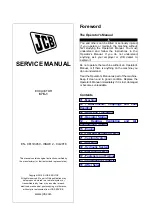
2 - SAFETY INFORMATION
Mounting and dismounting
Mount and dismount the machine only at designated lo-
cations that have handholds, steps, and/or or ladders.
Do not jump off of the machine.
Make sure that steps, ladders, and platforms remain
clean and clear of debris and foreign substances. Injury
may result from slippery surfaces.
Face the machine when you mount and dismount the ma-
chine.
Maintain a three-point contact with steps, ladders, and
handholds.
Never mount or dismount from a moving machine.
Do not use the controls or accessories as handholds
when you enter or exit the cab.
Working at heights
When the normal use and maintenance of the machine
requires you to work at heights:
• Correctly use installed steps, ladders, and railings.
• Never use ladders, steps, or railings while the machine
is moving.
• Do not stand on surfaces that are not designated as
steps or platforms.
Do not use the machine as a lift, ladder, or platform for
working at heights.
Lifting and overhead loads
Never use loader buckets, forks, etc. or other lifting, han-
dling, or digging equipment to lift persons.
Do not use raised equipment as a work platform.
Know the full area of movement of the machine and equip-
ment and do not enter or permit anyone to enter the area
of movement while the machine is in operation.
Never enter or permit anyone to enter the area under-
neath raised equipment. Equipment and/or loads can fall
unexpectedly and crush persons underneath it.
Do not leave equipment in raised position while parked
or during service, unless securely supported. Hydraulic
cylinders must be mechanically locked or supported if
they are left in a raised position for service or access.
Loader buckets, forks, etc. or other lifting, handling, or
digging equipment and its load will change the center of
gravity of the machine. This can cause the machine to tip
on slopes or uneven ground.
Load items can fall off the loader bucket or lifting equip-
ment and crush the operator. Care must be taken when
lifting a load. Use proper lifting equipment.
Do not lift load higher than necessary. Lower loads to
transport. Remember to leave appropriate clearance to
the ground and other obstacles.
Equipment and associated loads can block visibility and
cause an accident. Do not operate with insufficient visi-
bility.
Before using the machine
• Avoid loose fitting clothing, loose or uncovered long
hair, jewelry or any other items which could get caught
up in machinery.
• Different types of job will require different types of pro-
tective equipment. Items such as hard hats, safety
shoes, heavy gloves, reflector type jackets, respirators,
ear protection and eye protection may be required. Be-
fore starting a job, determine what protective equip-
ment will be necessary. Use this equipment at all times.
• Do not attempt to operate this machine unless you have
first read and perfectly understood the safety messages
and instructions appearing in this manual.
• Operating the machine requires full attention and care
on the part of the operator can avoid accidents. Get
to know the machine's possibilities and limitations and
the working space required. There are areas of poor
visibility in the working range of the machine. Have
someone guide you for all areas where visibility is not
perfect.
• Grease, oil, mud or (in winter) ice on the steps and
access handles can cause accidents. Make sure they
are kept clean at all times.
• Every day, inspect the machine to detect any signs of
hydraulic fluid leakage. Tighten the connections or re-
place any defective components as necessary.
• Remove any obstructions which hinder visibility. Keep
the windshield, rear view mirror and windows clean at
all times.
• Make sure the windshield wiper works correctly.
• Make sure you are perfectly familiar with hand signals
in daily use on the worksite so as to be able to obtain
help with tight manoeuvres or when carrying out oper-
ations where visibility is poor.
2-6
Summary of Contents for CX75C SR
Page 14: ...1 GENERAL INFORMATION Machine components SMIL13CEX2515FB 1 SMIL13CEX2906FB 2 1 8 ...
Page 33: ...2 SAFETY INFORMATION SMIL13CEX2925HB 4 2 17 ...
Page 48: ...2 SAFETY INFORMATION 2 32 ...
Page 230: ...6 MAINTENANCE 6 84 ...
Page 241: ...8 SPECIFICATIONS Work range standard model SMIL13CEX2899HB 5 8 9 ...
Page 243: ...8 SPECIFICATIONS Work range blade type SMIL13CEX2900HB 6 8 11 ...
Page 248: ...8 SPECIFICATIONS 8 16 ...
Page 255: ......








































